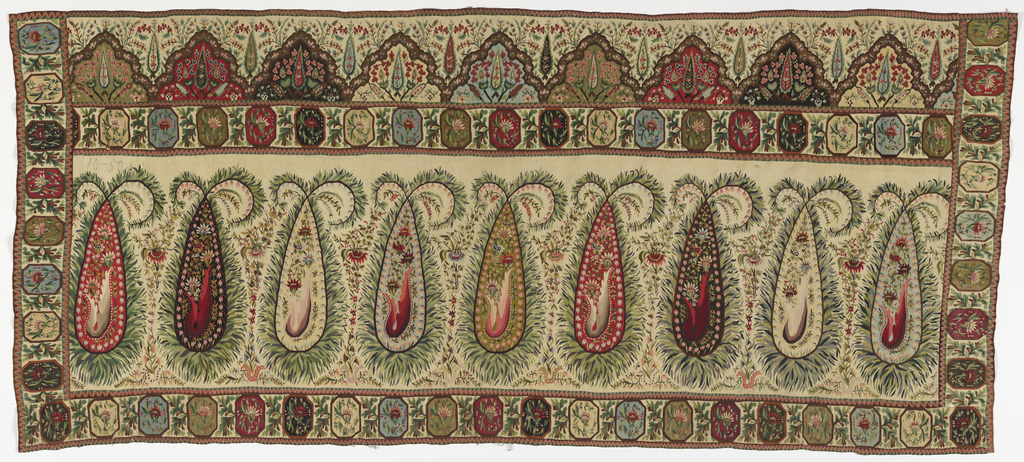There are 2 other images of this object. This image is in the public domain (free of copyright restrictions), and as such we offer a high-resolution image of it. See our image rights statement.
See more objects with the color darkkhaki grey darkolivegreen dimgrey darkslategrey or see all the colors for this object.
Object Timeline
|
1954 |
|
|
2008 |
|
|
2013 |
|
|
2014 |
|
|
2019 |
|
|
2024 |
|
Shawl Border (Russia)
This is a Shawl border. It was workshop of Dmitry Apollonovich Kolokol'tsev. It is dated early 19th century and we acquired it in 1954. Its medium is wool, silk and its technique is plain weave with discontinuous weft (tapestry). It is a part of the Textiles department.
Kashmir shawls were essential fashion accessories for stylish women of means in nineteenth-century Europe. Initially imported from India, they were superbly crafted and very expensive. Strong demand encouraged production of Kashmir-style shawls in several European countries. The French and British dominated European production using draw looms and jacquard looms. In contrast, Russian shawls were hand-woven, a function of the essentially feudal nature of the Russian economy in the early nineteenth century. The workforce consisted of enslaved serfs, many of who were very talented, highly skilled, and specially trained artisans.[i]
In about 1806, several small, estate-based textile workshops in Russia began the hand-woven production of Kashmir-style shawls. These workshops had previously produced carpets using reversible, plain weave, dovetail tapestry construction, a technique they applied with great success to shawls, producing two-sided fabrics of astonishing complexity.[ii]
Shawls from the Russian workshops won numerous prizes for their beautiful designs and fine craftsmanship at local and international exhibitions, including the Crystal Palace Exhibition of 1851 in London. After the abolition of serfdom in Russia in 1861, the cost of labor to hand-weave two sided shawl borders was prohibitive, and the production of these remarkable textiles in Russia largely came to an end.[iii]
[i] Priscilla Roosevelt, Life on a Russian Country Estate: A Social and Cultural History (New Haven: Yale University Press, 1995), 246-47.
[ii] L.V. Efimova, Russian Kerchiefs and Shawls, trans. Liudmila Lezhneva (Leningrad: Aurora Art Publishers, 1985), 28.
[iii] Efimova, Russian Shawls, 28.
This object was featured in our Object of the Week series in a post titled A Uniquely Two-Sided Shawl.
It is credited Museum purchase from Au Panier Fleuri Fund.
- Shawl Border (France)
- silk.
- Gift of Anonymous Donor.
- 1941-67-2
Its dimensions are
H x W: 62.5 × 140 cm (24 5/8 × 55 1/8 in.)
Cite this object as
Shawl Border (Russia); Workshop of Dmitry Apollonovich Kolokol'tsev ((Russian, n.d)); wool, silk; H x W: 62.5 × 140 cm (24 5/8 × 55 1/8 in.); Museum purchase from Au Panier Fleuri Fund; 1954-54-2
This object was previously on display as a part of the exhibition Paisley.

